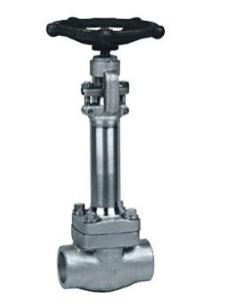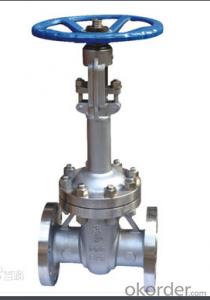Gate Valve Resilient Ductile Iron Britain Stardard
- Loading Port:
- Tianjin
- Payment Terms:
- TT OR LC
- Min Order Qty:
- 50 pc
- Supply Capability:
- 5000 pc/month
OKorder Service Pledge
OKorder Financial Service
You Might Also Like
1.Structure of Gate Valve Description:
A gate valve, also known as a sluice valve, is a valve that opens by lifting a round or rectangular gate/wedge out of the path of the fluid. The distinct feature of a gate valve is the sealing surfaces between the gate and seats are planar, so gate valves are often used when a straight-line flow of fluid and minimum restriction is desired. The gate faces can form a wedge shape or they can be parallel. Gate valves are primarily used to permit or prevent the flow of liquids, but typical gate valves shouldn't be used for regulating flow, unless they are specifically designed for that purpose. Because of their ability to cut through liquids, gate valves are often used in the petroleum industry. For extremely thick fluids, a specialty valve often known as a knife valve is used to cut through the liquid. On opening the gate valve, the flow path is enlarged in a highly nonlinear manner with respect to percent of opening. This means that flow rate does not change evenly with stem travel. Also, a partially open gate disk tends to vibrate from the fluid flow. Most of the flow change occurs near shutoff with a relatively high fluid velocity causing disk and seat wear and eventual leakage if used to regulate flow. Typical gate valves are designed to be fully opened or closed.When fully open, the typical gate valve has no obstruction in the flow path, resulting in very low friction loss.
2. Main Features of the Gate Valve:
• Valve body cavity using non-toxic epoxy resin,both inside and outside flashboard completely is coated with rubber
• Free of water pollution
• High manufacturing accuracy
• High strength
• Environmental protection and energy saving
• Good visual effect
3. Images


4. Gate valve Specification

5.FAQ
1. What's are the characteristics of gate valve?
The distinct feature of a gate valve is the sealing surfaces between the gate and seats are planar, so gate valves are often used when a straight-line flow of fluid and minimum restriction is desired. The gate faces can form a wedge shape or they can be parallel.
2. What is the work principle of gate valve ?
The gate faces can form a wedge shape or they can be parallel. Gate valves are primarily used to permit or prevent the flow of liquids, but typical gate valves shouldn't be used for regulating flow, unless they are specifically designed for that purpose. Because of their ability to cut through liquids, gate valves are often used in the petroleum industry.
3. What is the structure?
Bonnets provide leakproof closure for the valve body. Gate valves may have a screw-in, union, or bolted bonnet. Screw-in bonnet is the simplest, offering a durable, pressure-tight seal. Union bonnet is suitable for applications requiring frequent inspection and cleaning. It also gives the body added strength. Bolted bonnet is used for larger valves and higher pressure applications.
- Q: The difference between flanged gate valve and common gate valve
- Flange gate valve and ordinary gate valve difference is that the flange gate valve of good quality, durable and easy to install, but the price is a little high, generally used for large pipelines. Common, also available, such as small caliber, easy to change places.
- Q: greater than DN50 of the pipeline butterfly valve?
- Heating butterfly valve is flanged connection. Pressure capacity is stronger than gate valve and stop valve. For connection safety, do not use gate valve and stop valve wire connection
- Q: Does the relief valve have a gate valve?
- The pressure reducing valve group is composed of an adjustable pressure reducing valve, a pressure gauge, a copper valve, a Y filter, a rubber soft joint, a spring pressure gauge, a pressure gauge, an air valve, a pressure gauge and a bent pipe.
- Q: What are the main types of gate valves?
- According to the different materials for carbon steel valves, forged steel valves, stainless steel valves, cast steel valve, iron gate, ceramic valve;
- Q: Why the valve can only be fully open and fully closed valve can adjust the flow?
- Valve, if adjusted, it is easy to wash the sealing surface, resulting in sealing surface damage.
- Q: Is the gate valve flanged?
- The most commonly used gate valves are threaded connections, flanged connections, and welded connections.Like the outer thread connection, the clamp connection, the card sleeve is seldom used.
- Q: Does the tap belong to a stop valve or a gate valve?
- If it is about to pull open and close, it is cock valveIf it is rotated up and down, it is a stop valve
- Q: What is the allowable leakage rate of the gate valve D?
- In GB/T 13927, the leakage rate of the valve is divided into 10 grades, namely: A, AA, B, C, CC, D, E, EE, F, G class. And stipulates that when the order contract does not specify, the metal sealing valve according to D requirements.
- Q: What are the standards for the execution of cast iron dark pole gate valves?
- Standard Specification for cast iron blind rod gate valves:1, design and manufacture: according to the provisions of GB/T12234-892, structural length: according to the provisions of GB/T12221-893, flange size: according to the provisions of JB79 GB/T9112-91314, inspection and test: according to the provisions of JB/T9092-99 GB/T13927-92Drive mode: manual, electric, gear drive;
- Q: Why does the centrifugal pump start and stop in the case of closing the gate valve?
- The centrifugal pump starts and stops in the case of closing the pump outlet valve. Start off the pump outlet valve is to reduce the starting current, stop when the pump is closed, the outlet valve is to reduce water hammer, prevent blade from bad.
Send your message to us
Gate Valve Resilient Ductile Iron Britain Stardard
- Loading Port:
- Tianjin
- Payment Terms:
- TT OR LC
- Min Order Qty:
- 50 pc
- Supply Capability:
- 5000 pc/month
OKorder Service Pledge
OKorder Financial Service
Similar products
Hot products
Hot Searches
Related keywords




























